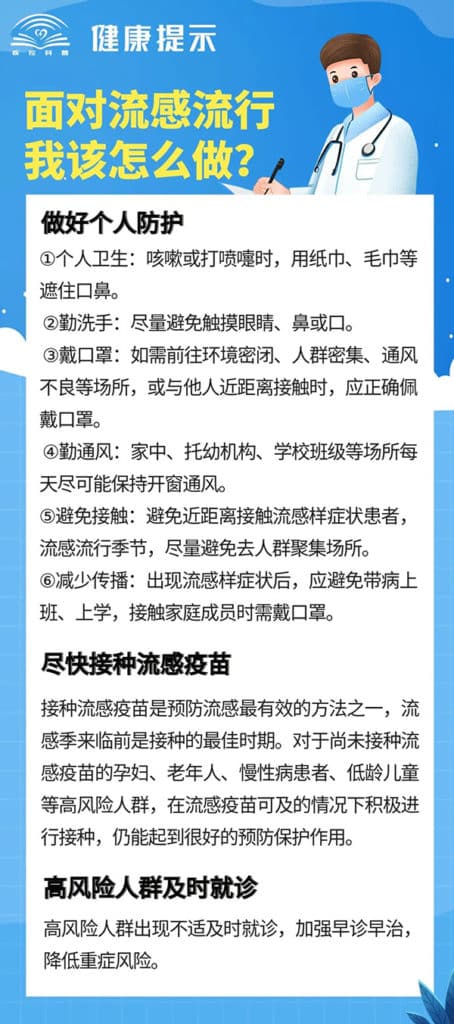How are flu trends developing?CDC: Inflection points have appeared in some provinces

[ad_1]
In response to the hot issues of influenza prevention and control that are of public concern, the China Centers for Disease Control and Prevention issued a document today pointing out that the level of influenza activity began to increase in early February 2023, and the upward trend was obvious after the end of February, reaching its peak in mid-March. Although the overall level is still at a high level, it has also been monitored that the peak of influenza activity in several provinces has reached an inflection point and has begun to decline.
Influenza season enters about 2 months later than previous years
Influenza is generally prevalent in winter. Why was there no influenza epidemic in the past winter, but it has appeared recently?
“This year entered the influenza epidemic season about 2 months later than in previous years. The influenza virus circulating this time is dominated by influenza A H1N1 subtype influenza virus, followed by influenza A H3N2 subtype influenza virus.” National Institute of Virology, China Center for Disease Control and Prevention Wang Dayan, director of the Influenza Center, introduced that influenza viruses can cause annual seasonal epidemics and irregular global influenza pandemics. Although there are many types and subtypes of influenza viruses, the ones that can cause seasonal epidemics in the population are influenza A, H1N1, H3N2 subtype and influenza B virus.
Why later than previous years? According to Wang Dayan, from the perspective of virus epidemics, in the past, the autumn and winter influenza epidemic season in my country generally started around the end of November, peaked in January of the following year, and lasted until around March. From December 2022 to January 2023, it coincides with the epidemic of the new crown virus. The measures to prevent and control the new crown are also very effective in the prevention and control of seasonal influenza, which will suppress the epidemic of influenza and other respiratory viruses to a certain extent.
At the same time, since most people will consciously stay at home, go to work or suspend work after being infected with the new crown virus, most primary and secondary schools and kindergartens will be on holiday, reducing the risk of crowd gathering and virus transmission, resulting in a low level of influenza activity at the end of 2022. There is a seasonal influenza epidemic.
From the perspective of autoimmunity, the A/H1N1 subtype influenza virus has not been prevalent in my country in the past three years, and the A/H3N2 subtype and B influenza have not caused high-level epidemics nationwide. The public has generally lowered their awareness of influenza prevention and control, and the influenza vaccination rate is low, resulting in a reduction in the pre-existing immunity of the population, especially children, to the H1N1 influenza virus.
After the implementation of “Class B and B control” for the new coronavirus infection in early 2023, the flow of international and domestic personnel and social activities have become normalized, and the influenza activity mainly of the A/H1N1 subtype has caused the peak of influenza in my country in spring. At the end of February 2023, influenza Activity rose rapidly, with a lag of about 2 months compared to previous normal flu seasons.
“Seasonal influenza is not only prevalent in autumn and winter, winter and spring. Southern provinces in my country often have a summer influenza peak in summer, which usually reaches its peak during June to July.” Wang Dayan added.
It’s not just children who are at high risk for flu
I feel that children around me have a lot of flu recently. Is the flu virus mainly infecting children?
According to Wang Dayan, according to estimates by the World Health Organization, seasonal influenza can cause 3 to 5 million severe cases and 290,000 to 650,000 respiratory disease-related deaths worldwide each year. The attack rate of influenza in children is about 20% to 30%. In the high epidemic season, the annual infection rate of influenza in children can be as high as 50%, which is higher than that in adults. Children under 5 years old, especially children under 2 years old are at high risk of influenza virus.
“The high-risk groups for influenza are not only children, but also the elderly over 60 years old, patients with chronic diseases, pregnant women, etc.” Wang Dayan said,
Judging from the actual infection situation, during the COVID-19 epidemic in December 2022, the adult group accounted for the highest proportion, while the number of cases in the age group under the age of 15 was significantly higher than other age groups at the peak of the influenza epidemic, and the clustered epidemics caused by influenza were also Mainly distributed in schools and childcare institutions.
Image source: China CDC
[ad_2]
Source link

![[Love Wants Sexual Happiness Series 358]Find the culprit and overcome psychogenic erectile dysfunction. Don’t let pressure affect your sexual happiness.](https://chinathenews.com/wp-content/uploads/2024/04/171111-780x420.jpg)

![[Wanqingyi Care]My health, my rights, customized medical methods in the last stage of life](https://chinathenews.com/wp-content/uploads/2024/04/ZZ1-100-780x420.jpg)
![[Kidney Transplantation Special Topic]The survival rate of transplanted kidneys is high without dialysis treatment three times a week](https://chinathenews.com/wp-content/uploads/2024/04/1311-780x420.jpg)



